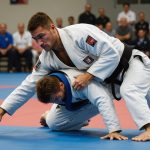Mastering Mat Control: Top Footwork Drills for UK Wrestlers to Elevate Performance
Understanding the Importance of Footwork in Wrestling
Footwork is the foundation of any successful wrestling career. It is the key to controlling the mat, evading opponents, and executing moves with precision. For UK wrestlers, mastering footwork drills is crucial for enhancing their overall performance and reducing the risk of injury.
“Wrestling is not just about strength; it’s about agility, strategy, and the ability to move efficiently on the mat,” says John Smith, a renowned wrestling coach. “Footwork drills help wrestlers develop the muscle memory and reflexes needed to outmaneuver their opponents.”
Also to see : Unlocking Success: How UK Boxing Coaches Strategically Employ Periodization for Effective Training Cycles
Basic Footwork Drills
Before diving into advanced techniques, it’s essential to establish a strong foundation with basic footwork drills. Here are some exercises that every wrestler should incorporate into their training:
Shuttle Runs
- Description: This drill involves rapid changes of direction, mimicking the movements you would make during a match.
- Execution: Start in a stance with your feet shoulder-width apart. Quickly move forward and backward, then side to side, mimicking the movements of a wrestling match.
- Benefits: Improves agility, speed, and reaction time.
Lateral Shuffles
- Description: This drill focuses on lateral movement, which is critical for defending and creating angles.
- Execution: Stand with your feet together and your knees slightly bent. Shuffle to one side, keeping your feet close to the ground, and then return to the starting position. Repeat on the other side.
- Benefits: Enhances lateral speed and stability.
Forward and Backward Sprints
- Description: These sprints help build explosive power and endurance.
- Execution: Sprint forward for 10-15 meters, then quickly turn around and sprint back to the starting point.
- Benefits: Increases speed, power, and cardiovascular endurance.
Advanced Footwork Drills
Once you’ve mastered the basics, it’s time to move on to more advanced drills that simulate real match scenarios.
In the same genre : Essential Conditioning Strategies for UK Fencers to Excel Throughout Prolonged Tournaments
Circle Drills
- Description: This drill involves moving around a partner or a cone in a circular motion.
- Execution: Have a partner stand in the center or place a cone there. Move around them in a circle, using different footwork patterns such as shuffles, crossovers, and carioca drills.
- Benefits: Improves agility, coordination, and the ability to change direction quickly.
Partner Resistance Drills
- Description: These drills involve working with a partner who provides resistance to simulate match conditions.
- Execution: Have your partner apply gentle to moderate resistance as you move in different directions. Practice shuffling, backpedaling, and advancing while your partner resists your movements.
- Benefits: Enhances strength, endurance, and the ability to move effectively against resistance.
Strength Training and Conditioning
Footwork is closely linked to overall strength and conditioning. Here are some key exercises and tips to integrate into your workout routine:
Strength Training Exercises
| Exercise | Description | Benefits |
|---|---|---|
| Squats | Stand with feet shoulder-width apart, then bend knees and lower body. | Strengthens legs and core. |
| Lunges | Step forward with one foot, lower body until back knee almost touches ground. | Improves balance and leg strength. |
| Press Ups | Start in plank position, lower body until chest almost touches ground. | Strengthens upper body and core. |
| Deadlifts | Stand with feet shoulder-width apart, bend down and lift weight with legs. | Enhances overall strength and muscle mass. |
| Leg Press | Sit in leg press machine, push platform away with feet. | Targets leg muscles specifically. |
Conditioning Tips
- High-Intensity Interval Training (HIIT): Incorporate HIIT into your workout routine to improve cardiovascular endurance and increase your heart rate efficiently.
- Plyometric Exercises: Include plyometric exercises like jump squats and box jumps to enhance explosive power.
- Core Strengthening: A strong core is essential for stability and balance on the mat. Incorporate exercises like planks, Russian twists, and leg raises into your routine.
Injury Prevention and Recovery
Injury prevention and recovery are critical components of any wrestling training program. Here are some tips and exercises to help you stay injury-free and recover effectively:
Warm-Up and Cool-Down Routines
- Dynamic Stretching: Before any workout or match, perform dynamic stretches like leg swings, arm circles, and hip rotations to prepare your muscles.
- Static Stretching: After your workout or match, engage in static stretches to help your muscles recover and reduce muscle soreness.
Muscle Relaxation and Recovery
- Use Natural Muscle Relaxers: Products like natural muscle relaxers can help reduce muscle pain and inflammation after intense workouts[3].
- Rest and Recovery: Ensure you get adequate rest and recovery time. This includes getting enough sleep and taking rest days as needed.
Linking Footwork to Other Martial Arts
Footwork in wrestling shares similarities with other martial arts and combat sports. Here’s how you can benefit from cross-training:
Boxing and Footwork
- Boxing emphasizes quick, agile movements that are highly beneficial for wrestlers. Incorporating boxing drills into your training can improve your foot speed and reaction time[2].
Brazilian Jiu-Jitsu and Footwork
- Brazilian jiu-jitsu (BJJ) involves a lot of ground movement, but the principles of footwork on the mat are similar. Practicing BJJ can help wrestlers improve their transitions and control on the ground.
Practical Insights and Actionable Advice
Here are some practical tips and advice to help you integrate these drills into your training:
Create a Training Schedule
- Plan your training sessions to include a mix of footwork drills, strength training, and conditioning exercises. Ensure you have dedicated time for warm-ups, cool-downs, and recovery.
Use Visual Aids and Feedback
- Use mirrors or record yourself performing drills to analyze your technique. Feedback from coaches or experienced wrestlers can also be invaluable.
Stay Hydrated and Focused
- Proper hydration and nutrition are essential for optimal performance. Stay focused during your training sessions by setting clear goals and tracking your progress.
Mastering footwork is a journey that requires dedication, consistency, and a well-rounded training approach. By incorporating these drills, strength training exercises, and injury prevention tips into your routine, you can significantly elevate your performance on the mat.
“Footwork is the backbone of wrestling. It’s what separates the good wrestlers from the great ones,” says Mark Schultz, an Olympic gold medalist in wrestling. “With the right training and mindset, any wrestler can master the art of footwork and achieve greatness.”
By following these guidelines and staying committed to your training, you can become a more agile, powerful, and effective wrestler, ready to take on any challenge the mat presents.






